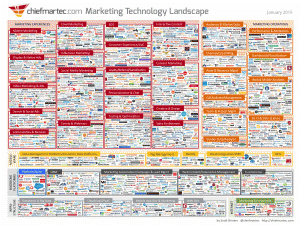
In 2014, Scott Brinker’s iconic martech landscape really got big, with 1,900 companies in 43 categories. Marketers who understood what was happening really freaked out.
The next one will have 5,000 logos. Don’t panic.

Scott Brinker’s martech landscape for 2014 (published in Jan. 2015)
There is a way to escape martech hell. To de-clutter your marketing technology life. And to simplify and rationalize your marketing technology stack. At TUNE, we call it MobileBest, and there are just four components — four things you need to escape martech spaghetti.
(Martech spaghetti, by the way, is complexity in your tech stack. You don’t know where one thing ends and another begins. You don’t know how components are connected. Many pieces are adjacent to others, but they’re not integrated. And you never really know how pulling on one strand is going to affect all the others.)
Two of them are mindsets, and two of them are technologies.
One: Customers are at the center (mindset)
You don’t do email marketing. You don’t do social media marketing. And you don’t do mobile marketing, search marketing, outdoor marketing, event marketing … the list goes on.
Instead, you do people marketing.
 Sure, you use different media, different technologies, and different techniques. But essentially, whether you’re in B2C or B2B, you are marketing to people. That means people are at the center of everything you do … and that means deep knowledge about people needs to be right in the middle of your marketing technology.
Sure, you use different media, different technologies, and different techniques. But essentially, whether you’re in B2C or B2B, you are marketing to people. That means people are at the center of everything you do … and that means deep knowledge about people needs to be right in the middle of your marketing technology.
Most martech is channel-centric, which is exactly how marketers build tech stacks that are really blobs, and tech blobs that are really spaghetti: martech spaghetti.
Your martech needs to be people-centric. And that will affect how you buy, implement, integrate, and use marketing technology tools. (Hint: the biggest impact will be the technology that lives at the center of your stack. More on that later.)
Two: Understand the new mobile (mindset)
Marketers who saw Brinker’s 2014 landscape freaked out, but there was something else happening at the same time that they did not know … that they could not know.
2014 was peak app in America.
 That year, each of us might have downloaded and installed two to three apps every month. Ever since then, we’ve installed fewer apps per person. In 2016, we downloaded about 1.5 apps per person, per month.
That year, each of us might have downloaded and installed two to three apps every month. Ever since then, we’ve installed fewer apps per person. In 2016, we downloaded about 1.5 apps per person, per month.
But mobile isn’t just mobile apps. It’s everything, and I mean that quite literally.
Mobile has eaten all the other channels. All the traditional marketing channels that marketers have bought expensive martech systems for — email, web, social, search, video — are essentially mobile. In fact, 68% of all digital time is mobile time.
Essentially, mobile has become the ecosystem within which all the other channels live … in which all the mobile moments, if you will, exist. That largely includes the new channels too: bots, agents or assistants, and of course, good old apps.
Increasingly, mobile is our gateway to the digital universe.
And increasingly, as digital makes up a larger and larger portion of our experience, mobile is our gateway to everything, both digital and analog. The form factor may change, augmented and virtual reality tools may mediate our experience, the phone might migrate onto our faces, embedded in a 2019 pair of Warby Parkers, but essentially, the function remains, and gets extended.
Now we can get into the martech
With me so far?
People are at the center, and people experience digital reality (and increasingly analog “real” life) through mobile.
Now we can get into the technologies.
Three: Measurement is the standard (technology)
Einstein is famous for many things. One of them is this quote:
“Not everything that counts can be counted, and not everything that can be counted, counts.”
– Albert Einstein
I agree with this quote. It’s true in many ways and areas of life. But it’s not true for marketing. For marketers, I would adjust Einstein’s quote to the following:
“Not everything that can be measured matters, but everything that matters can be measured.”
– John Koetsier
It is likely foolish and arrogant to contradict Albert Einstein. I mean, the scientist who discovered relativity, understood the relationship between matter and energy, and unlocked the doors to the quantum universe we are still just beginning to explore?
 But for marketing, I think this is accurate.
But for marketing, I think this is accurate.
You can measure front-end metrics like impressions, clicks, installs. You can measure back-end metrics like sales, attention, engagement, shares, revenue. And you can measure satisfaction and brand affinity and perceived quality and many other je-ne-sais-crois measures that indicate how much a customer likes/wants/needs/loves you.
The reality is: modern marketers measure.
If they don’t — and we see those who do and those who don’t regularly — they do not experience sustained long-term success. TUNE clearly enables this now, and we have a very interesting service coming that will make measuring every important way that a prospect or customer interacts with you simple, easy, and entirely platform-agnostic.
Four: Marketing system of record (technology)
Finance has an accounting system from Oracle or IBM or Microsoft. Sales has a CRM system from Salesforce or another vendor. Fulfillment and Operations have ERP.
And marketing?
Marketing, largely, has had chewing gum and bailing wire.
Hence: martech spaghetti.
Marketers must develop and own their own systems of record in which they measure and manage prospect and customer data so that they can appropriately engage at significant stages in the customer journey and enhance each of marketing, customer experience, and profitability.
That system must be people-centric — remember what I hinted at earlier — and connect who a person is with actions that he or she has taken and hints about what he or she wants in the future. It must be both enrichable and queriable by vertical martech solutions or platforms so that marketers can orchestrate engagement from a single holistic perspective.
Look for interesting developments from TUNE in this area shortly.
Summing it all up
Martech spaghetti happens when tools are piled upon tools with no central vision guiding acquisition, deployment, and integration. Simplicity results from four key considerations:
- People are at the center
- Mobile is the ecosystem within which all the other channels live
- Measurement is the standard
- Marketing requires its own system of record
If you’re mired in martech spaghetti, we can help.
For information on how TUNE can help you build a MobileBest mindset and a MobileBest technology foundation, talk to us today.
Author
Before acting as a mobile economist for TUNE, John built the VB Insight research team at VentureBeat and managed teams creating software for partners like Intel and Disney. In addition, he led technical teams, built social sites and mobile apps, and consulted on mobile, social, and IoT. In 2014, he was named to Folio's top 100 of the media industry's "most innovative entrepreneurs and market shaker-uppers." John lives in British Columbia, Canada with his family, where he coaches baseball and hockey, though not at the same time.




[…] Get the full story at TUNE’s blog … […]
[…] 4 things all marketers need to kill martech spaghetti and simplify tech stacks, Tune […]